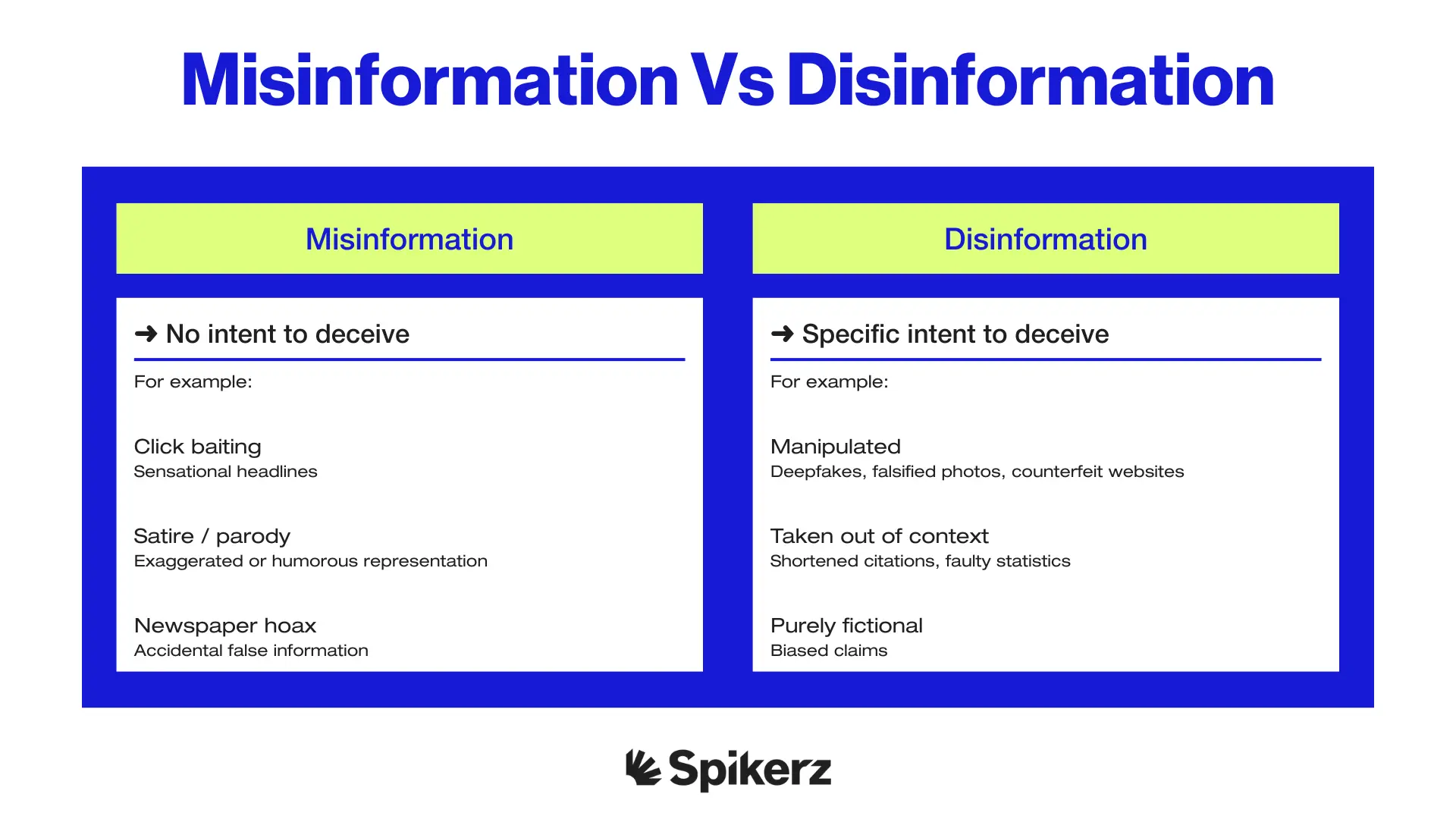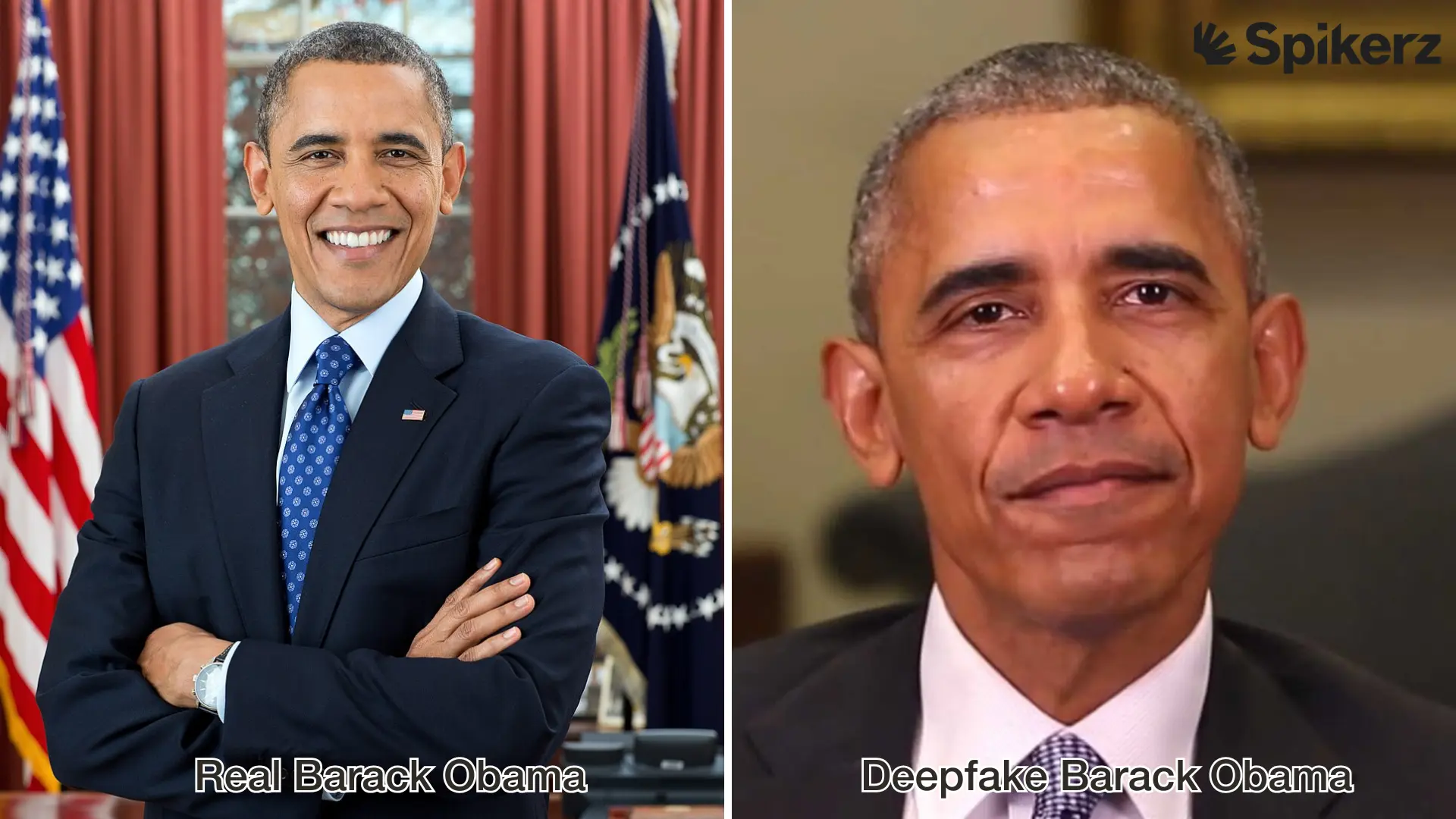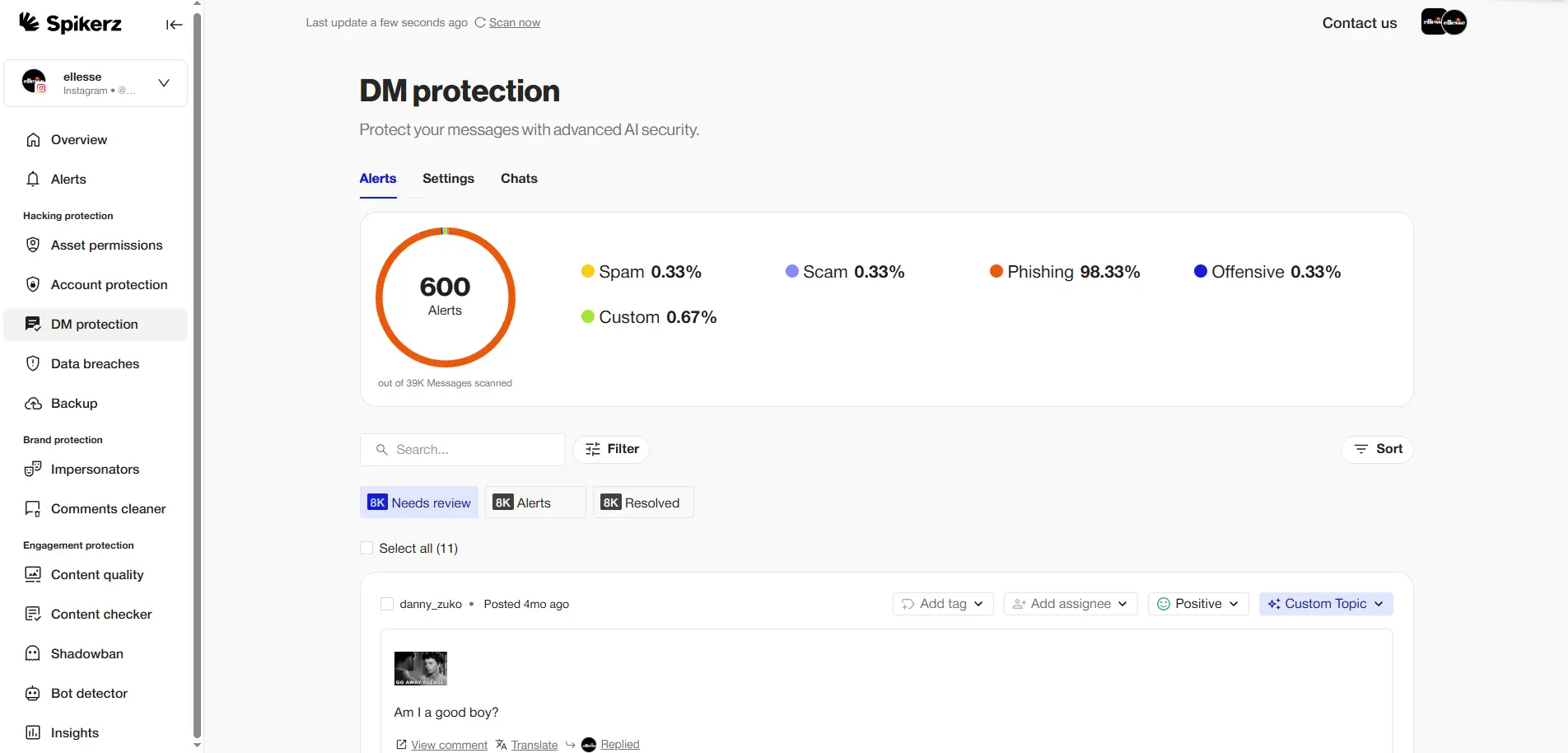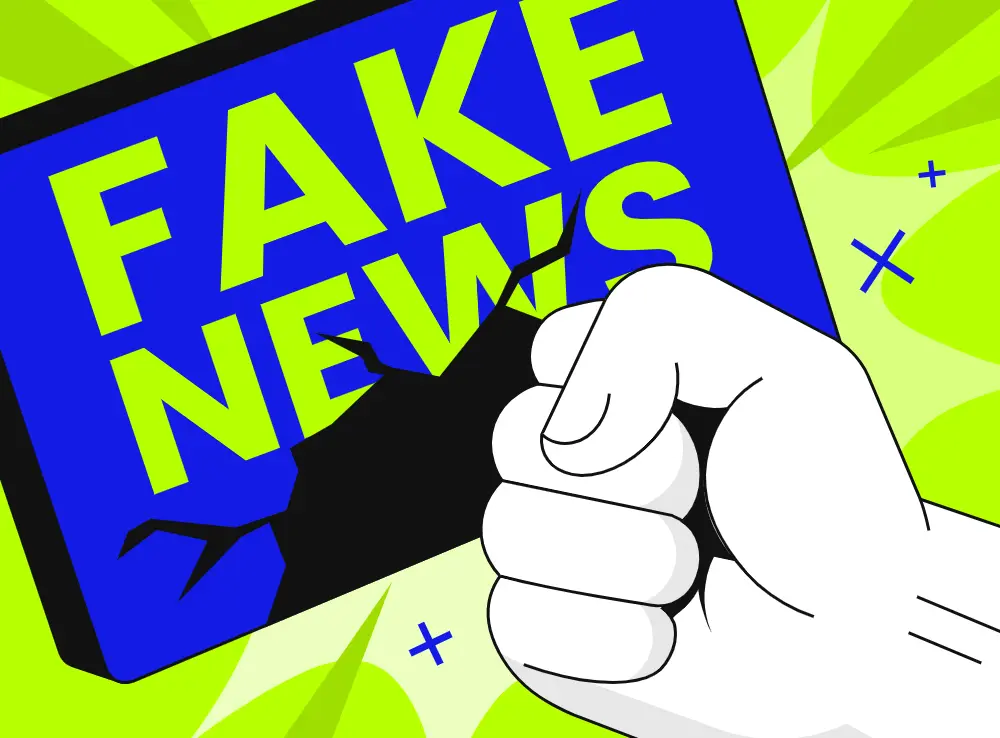How to Identify and Respond to Disinformation on Social Media
How to Identify and Respond to Disinformation on Social Media
Distinguishing real information from fake information has become increasingly difficult. Every day, false stories spread across social media platforms, reaching millions before anyone can verify them. A single fake post can travel around the world in minutes, creating confusion, damaging brands, and influencing public opinion.
But you don't have to be a victim of this. Thankfully, there are proven methods that exist to identify disinformation and protect your business from its harmful effects.
In this blog post, we’ll show you exactly how to spot false information, understand why it spreads, and take action to protect your organization's reputation and decision-making.
What Is Misinformation?
Misinformation is false or inaccurate information that spreads without the intention of deceiving others. It often happens when people share something they believe to be true, even though it's outdated, incomplete, or just plain wrong.
For example, someone might repost on their Facebook Feed an old news story without realizing the details are no longer accurate. The person sharing genuinely thinks they're helping inform others, but they're actually spreading false information.
What Is Disinformation?
Disinformation is false information that's created with the purpose to mislead, cause harm, influence public opinion, or obscure the truth for malicious or deceptive purposes. Unlike misinformation, disinformation is intentional: someone knows the information is false but spreads it anyway.
Disinformation is dangerous because it can shape the way people see important issues and make decisions based on lies. According to behavioral models, when people are exposed to misleading content, they become more likely to believe it and share it. Even those who recognize it as false may still pass it along to fit in with their social group, mock opponents, or gain attention online.
In politics, for example, disinformation might be used to disrupt elections by spreading fake stories or manipulated facts to confuse voters and undermine trust in democratic processes. These campaigns often target specific demographics with tailored messages designed to exploit existing beliefs or fears.
But the biggest issue is that the harm goes past politics. It can fuel fear, division, and conflict so it's harder for people to agree on what is real and what's not. When trust in reliable information breaks down, it's easier for harmful narratives to spread and harder for communities to work together.

How To Identify Disinformation On Social Media
Misinformation spreads differently on social media than on legacy media like television, radio, and newspapers. The reason for that is because social platforms lack the editorial oversight and fact-checking processes that traditional media outlets maintain. And unfortunately, it's not easy to identify targeted disinformation for what it is.
We need to take this under consideration and focus on what these campaigns fundamentally try to do: manipulate emotions, exploit biases, and create confusion.
If you understand these tactics, they’ll help you recognize disinformation before it influences your decisions or damages your business.
Here are effective ways to identify disinformation campaigns:

Tune In To Your Emotions
Emotions play a huge role in how we process information, especially online. Content that sparks outrage, fear, or anger often spreads because it grabs attention and triggers quick reactions.
That's exactly why disinformation often targets emotions first. When something triggers a strong feeling, it's easy to hit share without pausing to think about where it came from or why it was created. Bad actors know this and deliberately craft content to bypass your critical thinking.
But the good news is that tuning into your emotions helps break that cycle. If you notice yourself feeling suddenly outraged, it's worth asking why that piece of content is making you feel that way and what the sender's motive might be. Real news informs; disinformation inflames.
So slow down for a moment to give you space to recognize when you're being pushed into reacting instead of thinking. This doesn't mean shutting down your emotions but understanding how they can be used to manipulate your behavior and attention.
The same awareness applies when connecting with others. Instead of diving straight into what's right or wrong, pay attention to emotional drivers like anger, loneliness, or isolation to make conversations more constructive. People are more open when they feel understood, and emotions are usually at the core of why certain information or narratives resonate with them.
When you're mindful of how information makes you feel, it creates room for better choices. It helps reduce the chances of becoming an unknowing participant in spreading disinformation, and it strengthens trust in the information we choose to engage with and share.
Fact Check Information
The internet is full of information, but not all of it is accurate or trustworthy. Articles, videos, and posts can be outdated, biased, or intentionally misleading, and taking everything at face value makes it easy to fall for half-truths or outright lies.
This is why fact-checking is so important. It gives you the tools to sort through what is real and what is not. A good first step is to check who created the content so look into who wrote the article, whether they have expertise in the subject, and if the website is transparent about its purpose. Reliable sources usually have an "About Us" section, contact details, and clear citations.
It's also important to look closely at the details. Information has a shelf life, so always check the date to make sure what you're reading is still valid. Claims that seem convincing at first glance can fall apart when you trace the sources, since many so-called "official" groups or reports are biased or represent only a narrow perspective.
Headlines are another clue. If a headline feels exaggerated, overly emotional, or too shocking to be true, there's a good chance it was written to grab attention instead of informing. This is another tactic used in disinformation and clickbait, and it works because people share that kind of content quickly without overthinking it.
Look For Signs Of It Being Synthetic Media

Synthetic media, like deepfakes, can look and sound incredibly real, which makes them a great tool for spreading disinformation on social media. Learning to spot the signs of manipulated content matters because they are designed to convince people of events or statements that never actually happened.
Deepfakes are a serious danger because they can be used to impersonate public figures or trusted individuals to spread false narratives to influence opinions. They can also be used to damage people's or brand's reputations, for blackmail, or mislead investors with fake announcements to affect stock prices. In some cases, they can even be used to trick employees into giving away sensitive information or even bypass security systems.
Social media makes the problem worse since fake videos or audio clips can spread thousands of times in just minutes before anyone realizes they're fake. This rapid spread causes confusion, weakens trust, and gives a massive advantage to disinformation campaigns.
Paying attention to signs of synthetic media helps protect you from being misled and stops false content from spreading further. Look for unnatural eye movements, inconsistent lighting, or audio that doesn't quite match lip movements: these are often telltale signs of deepfake technology.
How To Protect Your Business From Disinformation On Social Media
There are a few effective ways to protect businesses from disinformation campaigns. With the right tools and strategies, you can detect and respond to false information before it damages your reputation or operations.
Here are some of the most effective ones:
Monitor Communications In Real-Time
Keep your team’s tools safe (whether it’s collaboration platforms, call centers or mobile phones) by protecting them from synthetic media like deepfakes. With real-time monitoring, you can detect manipulated audio and video in live communications, preventing attackers from impersonating executives or trusted contacts.
This protection applies to video conferences, phone calls, and voice messages. Advanced AI detection tools analyze voice patterns, facial movements, and other biometric markers to verify authenticity instantly.
Phishing Monitoring

Watch out for phishing attempts that look a little too real. With generative AI, attackers can now craft emails and direct messages on social media that accurately imitate your brand's identity or even copy the tone of your CEO or marketing team.
That’s why it’s important to regularly scan inbound communications. Automated systems can pick up on suspicious patterns and flag them before your employees click or respond. This way, your security team gets a heads-up about potential disinformation campaigns targeting your organization.
Analyze Content For Synthetic Media
Think about the content your business reviews every day: applications, claims, proposals. Any of it could be manipulated or even fully generated with AI. That’s why it’s so important to check for signs of synthetic media before relying on it.
Whether you’re reviewing customer complaints, insurance claims, or a new partnership proposal, having synthetic media detection in place helps you maintain the integrity of your business processes.
Social/Mass Media Monitoring
You’ve probably noticed how quickly false stories can spread online. Some of them aren’t random, they’re part of organized efforts to manipulate public opinion or damage a business’s reputation. These campaigns often target entire industries or single out specific businesses with false information meant to damage their reputation or manipulate market conditions.
That’s why active monitoring is so important. When you keep an eye on social media and news mentions of your brand, executives, and products, you can spot disinformation campaigns before they gain traction. Catching these narratives early gives you the chance to respond quickly and protect your reputation.
Account Takeover Prevention

One of the biggest risks to your business is when attackers manage to steal credentials. With the right malware, they can slip past authentication controls and take over accounts that your employees, partners, or customers trust. And once that happens, those accounts can be used to spread false information that looks like it’s coming from inside your organization.
The good news is there are simple actions that make a big difference. Strong authentication protocols, regular password updates, and continuous account monitoring help prevent these takeovers. And when they can't access legitimate accounts, they lose one of their most effective tools for spreading disinformation.
Conclusion
Disinformation threatens every business operating online. The speed at which false information spreads on social media means a single fake story can damage your reputation, mislead your customers, and disrupt your operations before you even know it exists. But you're not defenseless against these attacks.
Understanding the difference between misinformation and disinformation gives you the foundation to protect your business. When you know that disinformation is intentional deception while misinformation is accidental sharing of false information, you can better assess threats and respond appropriately.
Remember: emotions are the gateway to spreading false information; when content makes you angry or afraid, pause before sharing. Those emotions are exactly what false information feeds on.
The tools and strategies we've covered form your defense against disinformation campaigns. Protecting your business means staying alert, using the right technology, and ensuring your team understands these risks. Start implementing these protections today, waiting until after an attack is way too late.



